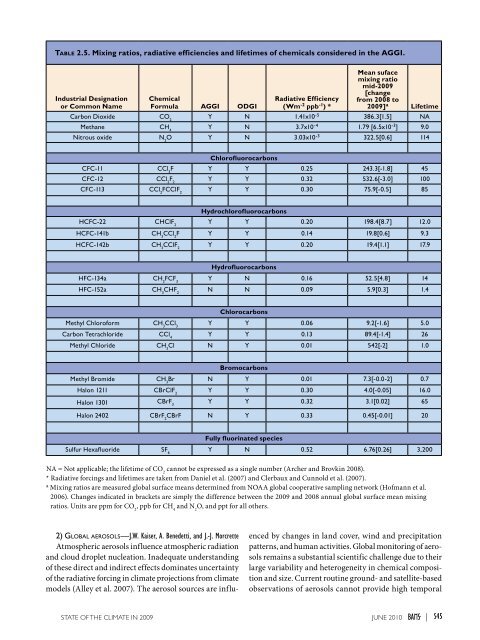You also want an ePaper? Increase the reach of your titles
YUMPU automatically turns print PDFs into web optimized ePapers that Google loves.
Table 2.5. Mixing ratios, radiative efficiencies and lifetimes of chemicals considered in the AGGI.Industrial Designationor Common NameChemicalFormula AGGI ODGIRadiative Efficiency(Wm -2 ppb -1 ) *Mean sufacemixing ratiomid-<strong>2009</strong>[changefrom 2008 to<strong>2009</strong>] a LifetimeCarbon Dioxide CO 2Y N 1.41x10 -5 386.3[1.5] NAMethane CH 4Y N 3.7x10 -4 1.79 [6.5x10 -3 ] 9.0Nitrous oxide N 2O Y N 3.03x10 -3 322.5[0.6] 114ChlorofluorocarbonsCFC-11 CCl 3F Y Y 0.25 243.3[-1.8] 45CFC-12 CCl 2F 2Y Y 0.32 532.6[-3.0] 100CFC-113 CCl 2FCClF 2Y Y 0.30 75.9[-0.5] 85HydrochlorofluorocarbonsHCFC-22 CHClF 2Y Y 0.20 198.4[8.7] 12.0HCFC-141b CH 3CCl 2F Y Y 0.14 19.8[0.6] 9.3HCFC-142b CH 3CClF 2Y Y 0.20 19.4[1.1] 17.9HydrofluorocarbonsHFC-134a CH 2FCF 3Y N 0.16 52.5[4.8] 14HFC-152a CH 3CHF 2N N 0.09 5.9[0.3] 1.4ChlorocarbonsMethyl Chloroform CH 3CCl 3Y Y 0.06 9.2[-1.6] 5.0Carbon Tetrachloride CCl 4Y Y 0.13 89.4[-1.4] 26Methyl Chloride CH 3Cl N Y 0.01 542[-2] 1.0BromocarbonsMethyl Bromide CH 3Br N Y 0.01 7.3[-0.0-2] 0.7Halon 1211 CBrClF 2Y Y 0.30 4.0[-0.05] 16.0Halon 1301 CBrF 3Y Y 0.32 3.1[0.02] 65Halon 2402 CBrF 2CBrF N Y 0.33 0.45[-0.01] 20Fully fluorinated speciesSulfur Hexafluoride SF 6Y N 0.52 6.76[0.26] 3,200NA = Not applicable; the lifetime of CO 2cannot be expressed as a single number (Archer and Brovkin 2008).* Radiative forcings and lifetimes are taken from Daniel et al. (2007) and Clerbaux and Cunnold et al. (2007).aMixing ratios are measured global surface means determined from NOAA global cooperative sampling network (Hofmann et al.2006). Changes indicated in brackets are simply the difference between the <strong>2009</strong> and 2008 annual global surface mean mixingratios. Units are ppm for CO 2, ppb for CH 4and N 2O, and ppt for all others.2) Global aerosols—J.W. Kaiser, A. Benedetti, and J.-J. MorcretteAtmospheric aerosols influence atmospheric radiationand cloud droplet nucleation. Inadequate understandingof these direct and indirect effects dominates uncertaintyof the radiative forcing in climate projections from climatemodels (Alley et al. 2007). The aerosol sources are influencedby changes in land cover, wind and precipitationpatterns, and human activities. Global monitoring of aerosolsremains a substantial scientific challenge due to theirlarge variability and heterogeneity in chemical compositionand size. Current routine ground- and satellite-basedobservations of aerosols cannot provide high temporal<strong>STATE</strong> <strong>OF</strong> <strong>THE</strong> <strong>CLIMATE</strong> <strong>IN</strong> <strong>2009</strong> juNE 2010 |S45
















